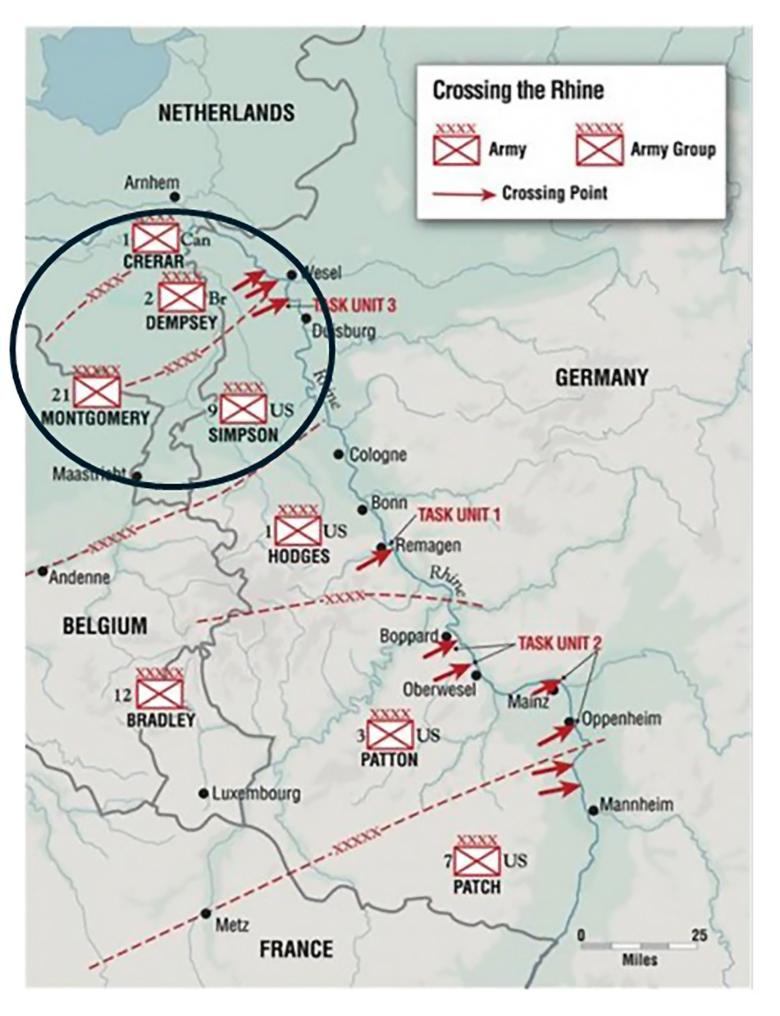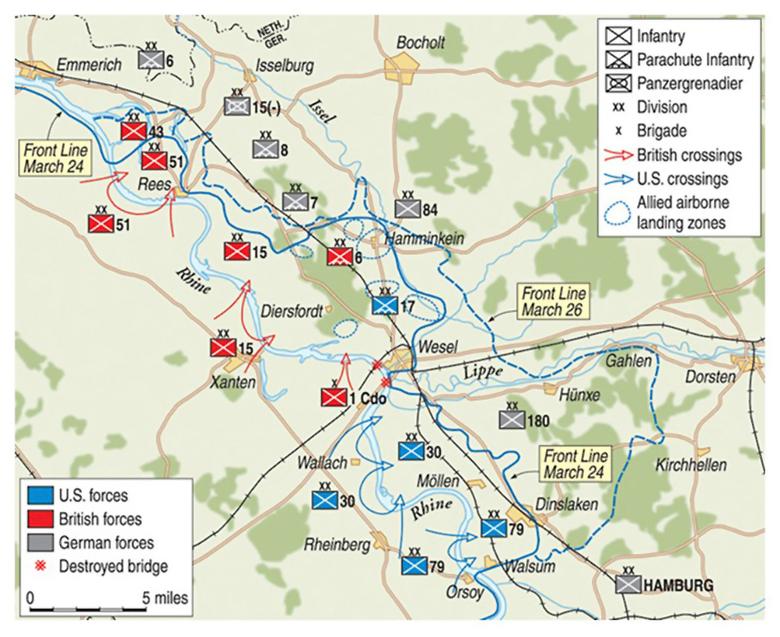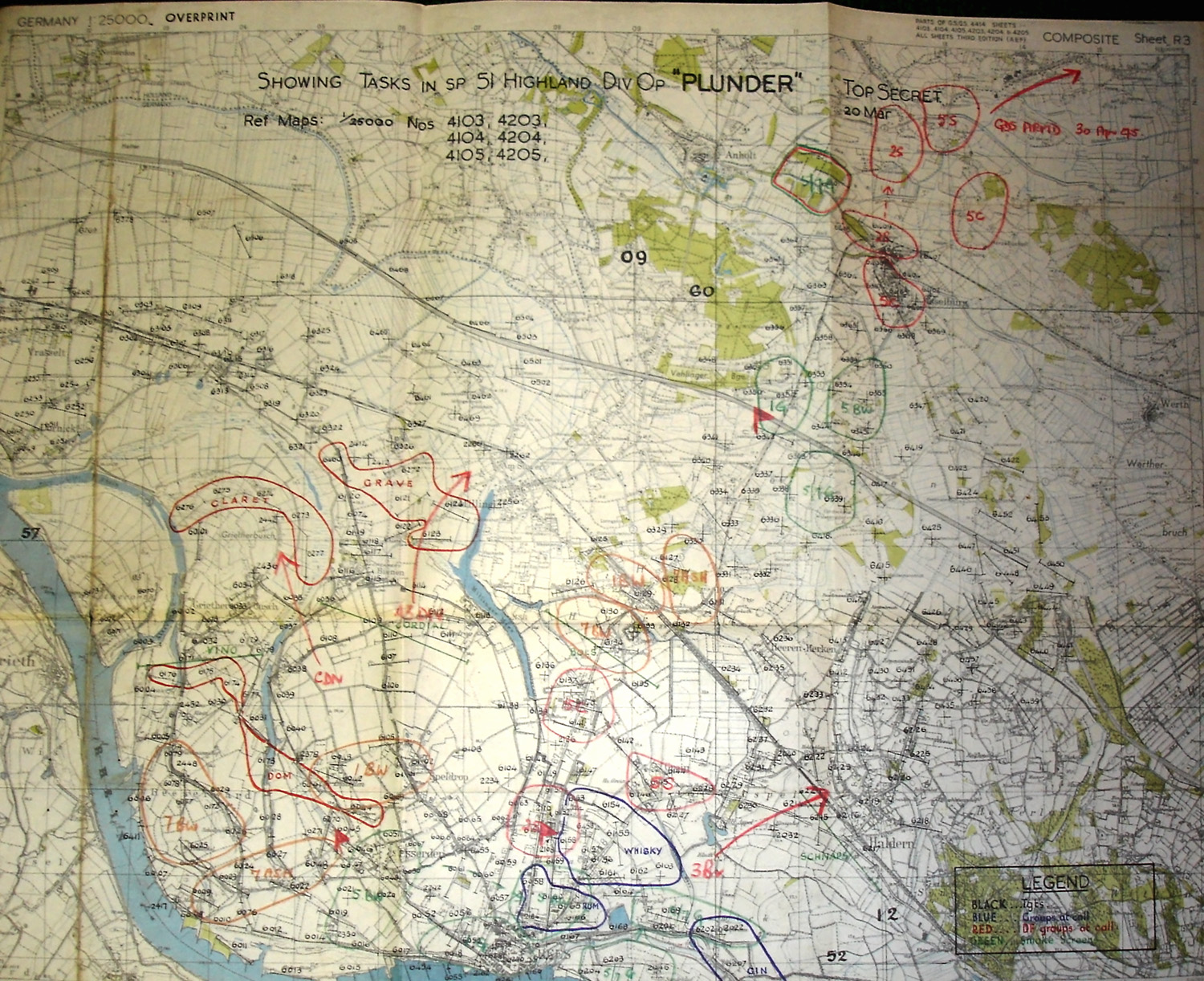Rhine Crossing - Operation Plunder
March 1945
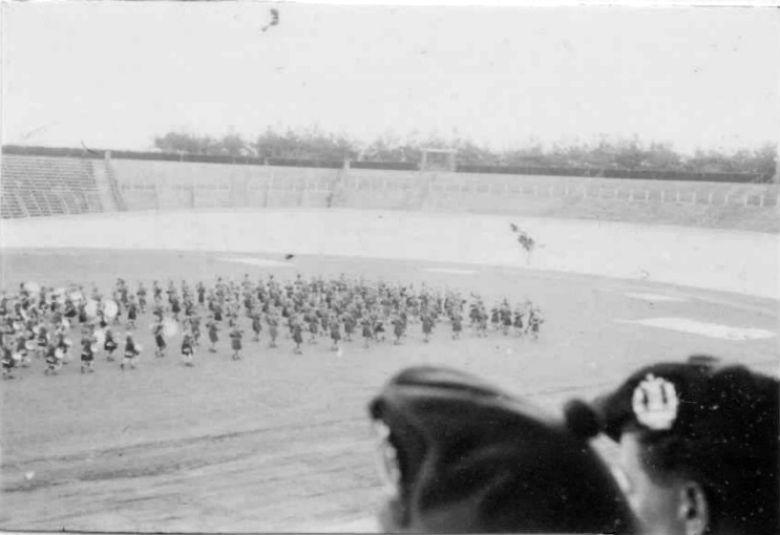
Nijmegen Pipes & Drums
show infoDescription:
The handwritten caption reads "[Beating the] Retreat by the 51st Highland Division massed Pipes & Drums at Nijmegen, 2nd March 1945, in commemoration of losses in Ardennes and Reichswald"
The photo was taken at Goffert Stadion by B. van Wulfften Palthe, a Dutch Interpreter with Corps. Tolken attached to 152 Brig.
Credit:
B. van Wullften Palthe
Tags:
Introduction to Op Plunder
The Operation to cross the Rhine was to be called Operation Plunder.
In preparation for the Rhine crossing the Division moved to a concentration area in Roermond and Nijmegen, here there was time for relaxation, reunions and several beating retreats took place (see photos). The Northants Yeomanry who had been away carrying out amphibious training with their Buffalo (amphibious armoured vehicles) rejoined the Division.
In preparation for Operation Plunder "Notes on Town Clearing" (written by Lt Col JA Grant-Peterkin, Commanding 1 Gordons) were issued by Main HQ to HQ 30 Corps.
"Notes on Town Clearing", written by Lt Col JA GRANT-PETERKIN, DSO, O.C., 1 GORDONS, on the experiences of a Battalion which took part in clearing two large towns, GENNEP and GOCH, against a determined and organised enemy...
Op Plunder
Briefings for the Division on the 9th and 11th March were followed by a rehearsal for the Rhine crossing on the River Maas on the 14th March.
Operation Plunder was a military operation to cross the Rhine on the night of 23 March 1945, launched by the 21st Army Group under Field Marshal Bernard Montgomery. The crossing of the river was at Rees, Wesel, and south of the river Lippe by the British Second Army under Lieutenant General Miles Dempsey, and the United States Ninth Army under Lieutenant General William H. Simpson.
The plan for the Rhine crossing required a two corps frontage, 30 Corps on the left and 12 Corps on the right. Each would be lead by one of the three Scottish Divisions, the 51st in the case of 30 Corps and the 15th Scottish Division in that of 12 Corps. In addition on the extreme south were the 1st Commando Brigade.
The first map below shows the whole Allied Plan for the crossing. The blue circle shows Montgomery’s 21st Army Group.
The second map shows Dempsey’s 2nd British Army with 51st Highland Division crossing at Rees.
THE DIVISIONAL PLAN
The Division would attack two brigades up with 154 Brigade on the left and 153 Brigade on the right with 152 Brigade behind 153 Brigade and the 9th Canadian Brigade on the left flank. The brigade tasks were:
- 154 Brigade. To hold the east bank of the Rhine as far north as Wardmannshof and to capture the villages of Klein Esserden, Speldrop and Bienen. They were then to advance north to Millengen and Grietherbosch.To conduct this latter task the Highland Light Infantry of Canada from the 9th Canadian Brigade would be under command.
- 153 Brigade. To capture the village of Esserden, block the approaches to Rees from the north, north east and east, take Rees and then exploit north on the Rees-Isselburg road. For this they would have the 2nd Seaforths from 152 Brigade under command.
- 152 Brigade (less 2nd Seaforths). To capture Mittelburg, Groin and Haldern and advance north on the Haldern - Isselburg road.
- The 43rd Division would follow up the 51st Highland Division.
Order of Battle
Divisional Commander
- Major General T G Rennie CB DSO MBE
152 BRIGADE Brigadier AJH Cassels C.B E., D.S.O
- 5 Camerons
- 5 Seaforths
153 BRIGADE Brigadier JR Sinclair D.S.O
- 5 Black Watch
- 5/7 Gordons
- 1 Gordons
- 2nd Seaforths (from 152 Brigade)
154 BRIGADE Brigadier JA Oliver C.B.E., D.S.O, TD
- 7 Black Watch
- 7 Argyll & Sutherland Highlanders
- 1 Black Watch
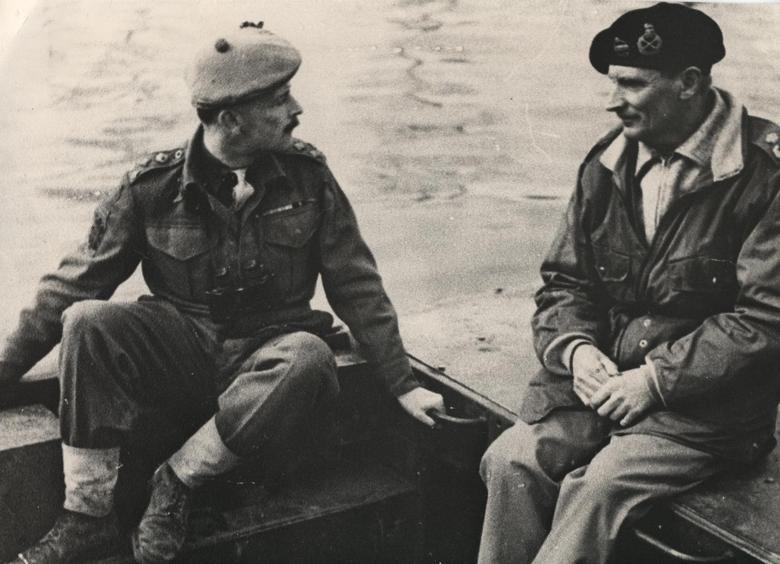
Brigadier James Oliver with FM Montgomery
show infoDescription:
Brigadier James Oliver with Field Marshall Montgomery
Tags:
In January 1944 Brigadier Oliver took command of 154 Brigade, which contained the 1st and 7th Black Watch and the 7th Argylls. He led it with consummate skill throughout the campaign in North West Europe. When the Highland Division's commander General Rennie, was killed by a mortar bomb on the banks of the Rhine brigadier Oliver temporarily commanded the division. He was appointed CBE in March 1945.
Notes written on the experience of a Battalion which took part in the clearing to two large towns during Operation Plunder (Rhine Crossing) March 1945.
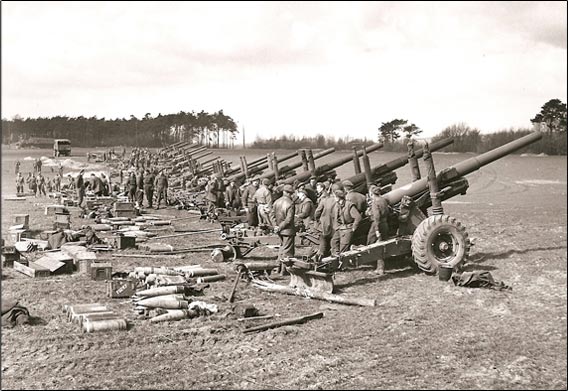
Royal Artillery Battery
show infoDescription:
The 5.5 inch guns of 235 and 336 Medium Batteries Royal Artillery line up to fire in support of the Rhine Crossing. 27th March 1945.
Copyright:
IMW - B 15767
Tags:
The crossing on the 23rd March was preceded by a huge preliminary bombardment which commenced at 1700hrs while smoke generators were used to screen the river.
An account of the Rhine Crossing by Albert Bellamy; Published in a local newspaper and kindly provided to us by Trooper Bellamy's Daughter.
The Divisional crossing began at 2100hrs. The time taken to cross the River was little more than two and a half minutes but it seemed longer to the exposed troops. Never the less the lead battalions of 154 Brigade crossed with few casualties and secured their initial objectives but their third battalion, 1 Black Watch, met very stiff resistance but by dawn had advanced to Speldrop.
An account of 154 Brigade's crossing of the Rhine in Operation Plunder, March 1945. This extract is taken from the 154 Brigade History.
On the right 153 Brigade's leading battalions crossed and established a bridgehead either side of Rees, although 5/7th Gordons on the right having crossed the Rhine were caught in the island formed by the Alter Rhine and pinned down. 1 Gordons in depth were committed to clearing through Rees.
153 Brigade Operations during Operation Plunder - the Rhine Crossing, March 1945.
Military Cross Citation - A/Captain A. Donaldson - REES - 23/24 March 1945. Citation given for his "coolness, courage, and unflinching devotion to duty" as subaltern in 'B' Coy. 2nd Bn. Seaforth Highlanders after Coy. Comd. was wounded crossing the Rhine. 2nd Seaforth Highlanders were under 153 Bde during Operation Plunder.
Just before midnight 152 Brigade began crossing. Advancing on Mittenburg they were held up by an antitank ditch. Their third battalion, the 5th Seaforths, were slow to cross as craft were now limited as a result of losses but they crossed at dawn (see photos) and moved up to Esserden under heavy shelling.
152 Brigade Operations during Operation Plunder - the Rhine Crossing - and the attack on Groin
The Germans now reinforced the 8th Parachute Division in the Divisional sector with 15th Panzer Grenadier Division. 1 Black Watch were forced out of Kleinesserden and 154 brigade withstood a number of counterattacks. 152 Brigade also had to withstand these counter attacks but, assisted by a squadron of Staffordshire Yeomanry, they managed to cross the antitank ditch that had held them up. Middleburg and Groin were taken and Rees cleared.
An account of the attack on Groin (Rhine Crossing - Operation Plunder) by 5th Seaforth Highlanders, taken with kind permission from "Battalion" by Alastair Borthwick.
A description of the 1st Gordon Highlanders crossing of the Rhine and subsequent fight through Rees during Operation Plunder, 24-26 March 1945. Extracts from "The History of the 51st Highland Division" by J. B. Salmon, and "So Few Got Through" by Martin Lindsay, reproduced here with kind permission.
From Martin Lindsay’s “So Few Got Through”, a description of an officer McNair's enthusiastic use of three 3.7 Howitzers in action in Rees, March 1945, during Operation Plunder.
PIOBAIREACHD was the name given to the 51st Highland Division newsletter which was produced from 14 June 1944.
The breakout now commenced with the Division pushing northeast to Anholt and Isselburg.
On 31 March the Commandeer of the 2nd Army wrote to the Division:
"Now that the Battle of the Rhine has been won, and the breakout from the bridgehead is well under way, I would like to give you and your magnificent Division my very sincere congratulations. Yours was one of the two divisions which carried out the assault across the river, defeated the enemy on the other side, and paved the way for all that followed. A great achievement - and I am sure you will all be very proud of it."
Sadly, among the casualties was the divisional commander, Major General T. G. Rennie, CB., D.S.O., M.B.E., was killed by a shell.
Appreciation of Major General T. G. Rennie, C.B., D.S.O., M.B.E. written on 31 March by the Commandeer of the 2nd Army, Lieutenant-General Sir Miles Dempsey. Major General Rennie was killed by a shell during Operation Plunder - The crossing of the Rhine. March 1945.

